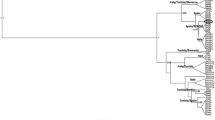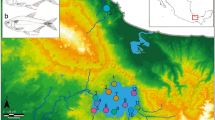Abstract
The presumption of intercontinental distributions of many species of Anomopoda has been reinforced by their considerable morphological uniformity and ease of passive dispersal via ephippial eggs. To test the validity of this dogma, genetic variation among taxa in the cladoceran genus Simocephalus was examined on a continental scale. Genetic variability (percentage polymorphic loci = 8.8%, individual heterozygosity = 3.4%) was comparable to that determined on a local scale in Simocephalus and somewhat less than for other zooplankton groups. Four species complexes were distinguished allozymically with unique allelic substitutions found for at least two loci between these taxa. Eight species in North America were differentiated within these complexes (Nei s genetic distance, D>0.30), all of which were clearly separated from two European species. Both S. cf. vetulus and S. cf. serrulatus are broadly distributed in North America, and intraspecific divergence is relatively low. In contrast, S. cf. congener and S. cf. exspinosus represent species complexes, both consisting of several species, differentiated allozymically and morphologically. The concept of generalist species with moderate genetic variation throughout a broad range and specialist species, genetically depauperate, with restricted distributions, is explored.
Similar content being viewed by others
References
Ayala, F. J., 1983. Enzymes as taxonomic characters. In G. S. Oxford & D. Rollinson (ed.), Protein polymorphism: Adaptive and taxonomic significance. Academic Press, London: 3–26.
Boileau, M. G. & P. D. N. Hebert, 1988. Electrophoretic characterization of two closely related species of Leptodiaptomus. Biochem. Syst. Ecol. 16: 329–332.
Edmondson, W. T., 1959. Freshwater Biology, 2nd edn. John Wiley & Sons, Inc., New York.
Flössner, D., 1972. Krebstiere, Crustacea, Kiemen- und Blattf üsser, Branchiopoda, Fischläuse, Branchiura. Die Tierwelt Deutschlands, Tiel 60.
Frey, D. G., 1973. Comparative morphology and biology of three species of Eurycercus (Chydoridae, Cladocera) with a description of Eurycercus macrocanthus sp. nov. Int. Rev. ges. Hydrobiol. 58: 221–267.
Frey, D. G., 1975. Subgeneric differentiation within Eurycercus (Cladocera, Chydoridae) and a new species from Northern Sweden. Hydrobiologia 46: 263–300.
Frey, D. G., 1978. A new species of Eurycercus (Cladocera, Chydoridae) from the southern United States. Tulane Stud. in Zool. Bot. 20: 1–25.
Frey, D. G., 1982. Questions concerning cosmopolitanism in Cladocera. Arch. Hydrobiol. 93: 484–502.
Frey, D. G., 1986. The non-cosmopolitanism of chydorid Cladocera: implications for biogeography and evolution. In K. L. Heck & R. H. Gore (eds), Crustacean Issues, Vol. 4, Crustacean Biogeography. A. A. Balkema, Rotterdam.
Frey, D. G., 1987a. The North American Chydorus faviformis (Cladocera, Chydoridae) and the honeycombed taxa of other continents. Phil. Trans. r. Soc., Lond. B315: 353–402.
Frey, D. G., 1987b. The taxonomy and biogeography of the Cladocera. Hydrobiologia 145 (Dev. Hydrobiol. 35): 5–17.
Fryer, G., 1991a. Functional morphology and the adaptive radiation of the Daphniidae (Branchiopoda: Anomopoda). Phil. trans. r. Soc., Lond. B331: 1–99.
Fryer, G., 1991b. A daphniid ephippium (Branchiopoda: Anomopoda) of Cretaceous age. Zool. J. Linn. Soc. 102: 163–167.
Hann, B. J., 1982.Two new species of Eurycercus (Bullatifrons) from eastern North America (Chydoridae, Cladocera). Taxonomy, ontogeny, and biology. Int. Rev. ges. Hydrobiol. 67: 585–610.
Hann, B. J., 1987. Naturally occurring interspecific hybridization in Simocephalus (Cladocera, Daphniidae): its potential significance. Hydrobiologia 145 (Dev. Hydrobiol. 35): 219–224.
Hann, B. J., 1990. Redescription of Eurycercus (Teretifrons) glacialis (Cladocera, Chydoridae), and description of a new species, E. (T.) nigracanthus, from Newfoundland, Canada. Can. J. Zool. 68: 2146–2157.
Hann, B. J. & P. D. N. Hebert, 1982. Re-interpretation of genetic variation in Simocephalus (Cladocera, Daphniidae). Genetics 102: 101–107.
Hann, B. J. & P. D. N. Hebert, 1986. Genetic variation and population differentiation in species of Simocephalus (Cladocera, Daphniidae). Can. J. Zool. 64: 2246–2256.
Hebert, P. D. N., 1974. Enzyme variability in natural populations of Daphnia magna. II. Genotypic frequencies in permanent populations. Genetics 77: 323–334.
Hebert, P. D. N. & M. J. Beaton, 1989. Methodologies for allozyme analysis using cellulose acetate electrophoresis. Helena Laboratories, Beaumont, Texas, USA.
Hebert, P. D. N. & T. L. Finston, 1993. A taxonomic reevaluation of North American Daphnia (Crustacea: Cladocera). I. The D. similis complex. Can. J. Zool. 71: 209–225.
Levene, H., 1949. On a matching problem arising in genetics. Ann. Math. Stat. 20: 91–94.
Lieder, U., 1983. Revision of the genus Bosmina Baird, 1845 (Crustacea, Cladocera). Int. Rev. ges. Hydrobiol. 68: 121–139.
Lynch, M. & W. Gabriel, 1987. Environmental tolerance. Am. Nat. 129: 283–303.
Michael, R. G. & D. G. Frey, 1983. Assumed amphi-Atlantic distribution of Oxyurella tenuicaudis (Cladocera, Chydoridae) denied by a new species from North America. Hydrobiologia 106: 3–35.
Michael, R. G. & D. G. Frey, 1984. Separation of Disparalona leei (Chien, 1970) in North America from D. rostrata (Koch, 1841) in Europe (Cladocera, Chydoridae). Hydrobiologia 114: 81–108.
Nei, M., 1978. Estimation of average heterozygosity and genetic distance from a small number of individuals. Genetics 89: 583–590.
Nevo, E., A. Beileo & R. Ben-Shlomo, 1983. The evolutionary significance of genetic diversity: ecological, demographic and life history correlates. In G. S. Mani (ed.), Evolutionary dynamics of genetic diversity. Lecture Notes in Biomath. 53: 13–213.
Pennak, R. W., 1978. Freshwater Invertebrates of the United States. 2nd edn. John Wiley & Sons, Inc., New York.
Richardson, B. J., P. R. Baverstock & M. Adams, 1986. Allozyme electrophoresis. A Handbook for animal systematics and population studies. Academic Press, NY, 410 pp.
Swofford, D. L. & R. K. Selander, 1989. BIOSYS-1 (Version 1.7): a computer program for the analysis of allelic variation in population genetics and biochemical systematics. Illinois Natural History Survey, Champaign.
Taylor, D. J. & P. D. N. Hebert, 1992. Daphnia galeata mendotae as a cryptic species complex with interspecific hybrids. Limnol. Oceanogr. 37: 658–665.
Thorpe, J. P., 1983. Enzyme variation, genetic distance and evolutionary divergence in relation to levels of taxonomic separation. In G. S. Oxford & D. Rollinson (eds), Protein polymorphism: adaptive and taxonomic significance. Academic Press, London: 131–153.
Ward, R. D., 1977. Relationship between enzyme heterozygosity and quaternary structure. Biochem. Genet. 15: 123–135.
Ward, R. D., R. M. Tollit & M. A. Bickerton, 1991. Genetic variation and reproductive mode in populations of Simocephalus vetulus (Branchiopoda: Cladocera) from the East Midlands of England. Freshwat. Biol. 25: 41–50.
Author information
Authors and Affiliations
Rights and permissions
About this article
Cite this article
Hann, B.J. Genetic variation in Simocephalus (Anomopoda: Daphniidae) in North America: patterns and consequences. Hydrobiologia 307, 9–14 (1995). https://doi.org/10.1007/BF00031992
Issue Date:
DOI: https://doi.org/10.1007/BF00031992




